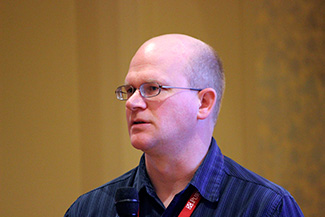Challenges to Multibreed Evaluation
Proper contemporary grouping and establishing modern heterosis estimates between breeds pose challenges.
by Raney Lovorn, Angus Journal® intern
BILOXI, Miss. (June 11, 2015) — Establishing an expected progeny difference (EPD) to bridge gaps between breeds and allow for maximization of potential genetic improvement in crossbred cattle is a difficult task. During the 2015 Beef Improvement Federation (BIF) Annual Convention, Wade Shafer and Larry Kuehn addressed the potential of using the Germplasm Evaluation Program (GPE) at the U.S. Meat Animal Research Center, Clay Center, Neb., to help make multibreed evaluation a reality.

Research data is needed where contemporary comparison is used for evaluation, Larry Kuehn said. In order to do that, purebred cattle must be involved in the system.
“We want to merge multiple breed data bases together. Structures are different, and we need a lot of cooperation to get multibreed done, as we know,” Kuehn said. “Estimation cost relation parameters are a lot of our problem now.”
The problem comes when the data arrives in the system and, although they have the data to estimate the EPD, they cannot input the information in a way that would put the breeds in the same contemporary group and allow them to easily compute the EPD, Kuehn continued.
“Really, the contemporary group is the problem,” Kuehn said. “ If we are turning in one set of the breed male sires out onto heavy-milking females, that is a different contemporary group, really.”
Research data is needed where contemporary comparison is used for evaluation, Kuehn said. In order to do that, purebred cattle must be involved in the system.
The current structure of the GPE at the moment is to use seedstock females and cross them with samples of purebred bulls to simulate one diallel cross, Kuehn said, to investigate the quantitative traits associated with crossbreeding.
“We are producing useful data for things like parameterization of breed differences that we release every year, as far as for the across-breed EPD program,” Kuehn said. The data have been used for several graduate student projects to establish breed differences and current heterosis estimates.
Currently, data is coming in from animal analysis of their 40,000 animal pedigrees from the research herd using all of the cycles and GPE data available. The information is then adjusted using a regression coefficient to put the solution on an industry scale, Kuehn explained.
Problems are associated with this data because it works on EPDs and cycles from bulls that were breed impacters more than 40 years ago. Their information needs to be phased out of the equation as their influence diminishes, Kuehn said.
“The proposal that we are talking about today is to use breed differences from the GPE to parameterize the multibreed model currently in use,” Kuehn said, “We can basically preadjust the data for the breed composition, and we need to consider where the programs are different and how to accommodate the difference."
The 2015 BIF Annual Convention was hosted by Mississippi State University and the Mississippi Extension Service June 9-12 at the Beau Rivage Casino and Hotel in Biloxi. The Angus Journal and LiveAuctions.tv provide comprehensive online coverage of the event at www.BIFconference.com. Visit the Newsroom for summaries, proceedings, PowerPoints and audio of the sessions; the Awards page for announcements of award winners; and the Photos page for photo galleries of the tour stops.
Editor’s Note: This summary was written under contract or by staff of the Angus Journal®. Through an agreement with the Beef Improvement Federation, we are encouraging reprinting of the articles to those who will adhere to the reprint guidelines available on this site. Please review those guidelines or contact Shauna Rose Hermel, editor, at 816-383-5270. PowerPoints are posted with permission of the presenter and may not be reproduced in whole or in part without the express permission of the presenter.
The Angus Journal's coverage of the event is made possible through collaboration with BIF and sponsorship of LiveAuctions.tv. For questions about this site, or to notify us of broken links, click here. Look for additional coverage in the Angus Journal, the Angus Beef Bulletin, the Angus Journal Daily, the Angus Beef Bulletin EXTRA and Angus TV.



